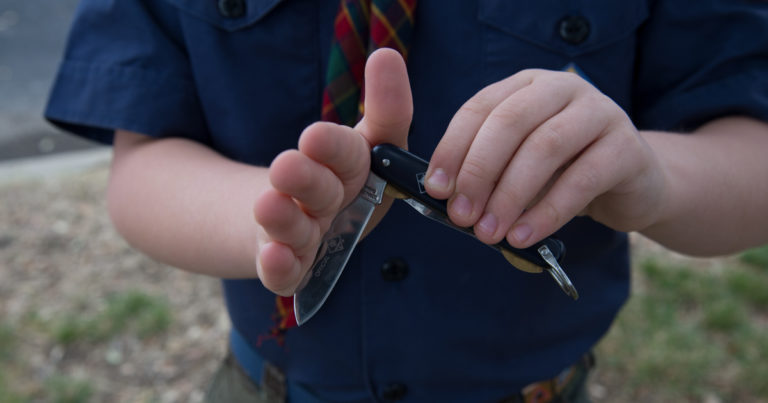Let’s be blunt about pocket knife safety

A sharp blade can be a useful tool when setting up camp, fishing or cooking. It can also be dangerous when used carelessly.
Policies vary among packs, troops, councils and camps when it comes to what blade types and lengths are allowed. The BSA sets no official standard on knife length.
But there’s one rule everyone agrees on: pocket knife use requires responsibility.
A tool, not a toy
Bears can start carrying a pocket knife after completing the Whittling Chip requirements. Boy Scouts must earn their Totin’ Chip, which also gives them the right to carry and use axes and saws. These rights, however, can be revoked if the Scout fails to be responsible.
Some big no-no’s:
- Throwing a knife
- Using a dull or dirty blade
- Handing a knife to someone blade first
- Cutting while others are within your “safety circle” (arm’s length)
- Carrying an open pocket knife
- Carving into something that doesn’t belong to you
- Cutting toward your body
Treating pocket knives with respect and using them accordingly not only ensures the Scout’s safety but also keeps others safe.
Sharp and clean
Part of pocket knife safety means maintaining the blade’s cleanliness and sharpness. To clean, open all the tools and use a toothpick or moist cloth to wipe dust and lint from inside the pocket knife. If you used any water for cleaning, apply a little light oil to the knife’s joints afterward.
Normal use dulls the blades, so get a sharpening stone. Hold the knife at a 25-degree angle against the stone and push the blade along it or move the blade in a circular motion. Sharpen both sides and wipe the blade. Check its sharpness by holding it under a bright light. If the edge of the blade doesn’t shine, it’s sharp.
A sharp knife is safer than a dull one because a dull blade can slip while cutting.
The right blade
The BSA recommends picking the right knife for the job.
Your Scout Shop has many knives to choose from, including single-bladed models and ones with all the bells and whistles. (OK, none has literal bells and whistles, but they have everything else you’d need.)
Single blades:
- Cub Scout Pocket Knife ($14.99 at ScoutStuff.org)
- Boy Scout Pocket Knife ($14.99 at ScoutStuff.org)
- BSA Folding Knife ($19.99 at ScoutStuff.org)
- BSA G10 Serrated Knife ($29.99 at ScoutStuff.org)
A little bit more:
- BSA Official Cub Scout Pocket Knife ($19.99 at ScoutStuff.org)
- Deluxe Pocket Scout Knife ($19.99 at ScoutStuff.org)
- Swiss Army Classic Knife ($24.99 at ScoutStuff.org)
- Cub Scout Tinker Swiss Army Knife ($29.99 at ScoutStuff.org)
The “Be Prepared for anything” models:
- Swiss Army Huntsman Knife ($39.99 at ScoutStuff.org)
- Swiss Army Eagle Scout Explorer Knife ($49.99 at ScoutStuff.org)
